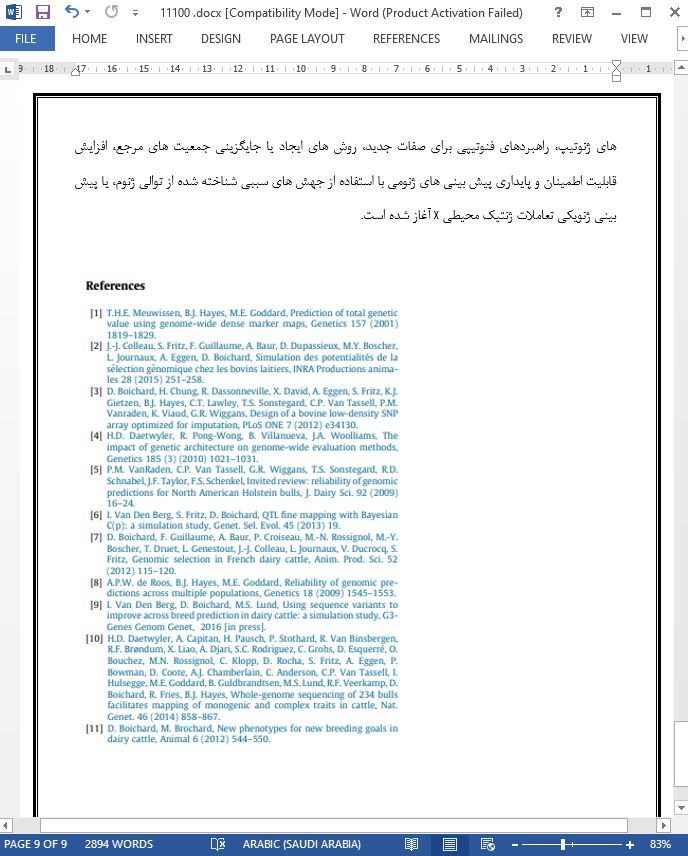
انتخاب ژنومیک در حیوانات اهلی: اصول، برنامه های کاربردی و دیدگاه ها
چکیده
اصول انتخاب ژنومیکی با عوامل اصلی مؤثر بر کارایی آن و فرض های اساسی مدل های مختلف پیشنهادی شرح داده شده است. دلیل اتخاذ سریع آن برای گاوهای شيری توضیح داده شد و شرایط کاربرد آن در گونه های دیگر مورد بحث قرار گرفت. دیدگاه های گسترش عبارتند از: انتخاب صفات جدید و اهداف جدید پرورش حیوانات؛ اتخاذ رویکردهای مقاوم تر مبتنی بر اطلاعات در انواع سببی؛ پیش بینی های تعاملات محیط نژادمانه (ژنوتیپ) x.
1.مقدمه
انتخاب مصنوعی در گونه های اهلی بر رخ مانه های خود حیوانات تا قرن ها مبنا بوده است. در طول سده بیستم نظریه شاخص انتخاب و سپس بهترین پیش بینی تا اریب خطی (BLUP رویکردی پیچیده تر با تکیه بر مدل های خطی مخلوط) استفاده اطلاعات در رخ مانه منسوب به پیش بینی «ارزش پرورش حیوانات» منتخبان را برای انتخاب اجازه داد. این امر به انتخاب موفقی از صفات رخ مانگی با وراثت پذیری متوسط یا بالا که براحتی ثبت شده اند منجر شد. اما در موثر بودن برای پیچیدگی صفات در اندازه گیری یا وراثت پذیری کم، به سرمایه گذاری رخ مانگی زیاد نیاز داشت. در طول 25 سال گذشته تعداد جایگاه های صفت كمي (یعنی مناطق ژنوم مسئول کسر واريانس ژنتيکی صفت) توسط مارکرهای ژنتیکی، با هموار کردن راه برای انتخاب به کمک مارکر (MAS) ، تعیین شده بود.
6. نتیجه گیری
انتخاب ژنومی در گاوها بسیار موفقیت آمیز بوده است زیرا باعث بهره بیشتر ژنتیک در هزینه های مشابه یا ارزان می شود. اما دیگر پیامدهای مهم و غالبا نادیده گرفته شده، فرصت های بزرگی است که آن برای صفات پیچیده انتخاب ارائه می دهد، برای صفاتی که هنوز انتخاب نشده اند اما برای تولید پایدار و برای مدیریت بهتر تغییرپذیری ژنتیکی در دراز مدت مهم هستند. انتخاب ژنومیک یک نوآوری بسیار جدید است. تحولات شدیدی از جمله کاهش هزینه های ژنوتیپ، راهبردهای فنوتیپی برای صفات جدید، روش های ایجاد یا جایگزینی جمعیت های مرجع، افزایش قابلیت اطمینان و پایداری پیش بینی های ژنومی با استفاده از جهش های سببی شناخته شده از توالی ژنوم، یا پیش بینی ژنویکی تعاملات ژنتیک محیطی xآغاز شده است.
Abstract
The principles of genomic selection are described, with the main factors affecting its efficiency and the assumptions underlying the different models proposed. The reasons of its fast adoption in dairy cattle are explained and the conditions of its application to other species are discussed. Perspectives of development include: selection for new traits and new breeding objectives; adoption of more robust approaches based on information on causal variants; predictions of genotype × environment interactions.
1. Introduction
Artificial selection in domestic species has been based for centuries on the own phenotypes of animals. During the 20th century, selection index theory first, then Best Linear Unbiased Prediction (BLUP–a more sophisticated approach relying on mixed linear models) allowed the use of information on phenotypes of relatives to predict ‘‘breeding values’’ of candidates for selection. This led to the successful selection of easily recorded phenotypic traits with moderate or high heritability. But to be efficient for traits difficult to measure or with low heritability required costly phenotyping investments. During the last 25 years, a number of Quantitative Trait Loci (i.e. regions of the genome responsible for a fraction of the genetic variance of a trait) have been mapped with genetic markers, paving the way to marker-assisted selection (MAS).
6. Conclusion
Genomic selection has been very successful in cattle because it provides more genetic gain at a similar or lower cost. But other important and often overlooked consequences are the huge opportunities it offers for traits difficult to select, for traits not yet selected, but important for sustainable production, and for a better management of the genetic variability on the long term. Genomic selection is a very recent innovation. Strong evolutions have started, including reduction in genotyping costs, phenotyping strategies for new traits, approaches for the creation or the replacement of reference populations, increase in robustness and persistency of genomic predictions using causal mutations identified from genome sequences, or genomic prediction of genetic environment interactions.
چکیده
1.مقدمه
2. داستان موفق انتخاب ژنومیک در گاو شیری
3. عوامل تنوع بازدهی انتخاب ژنومیک
4. شیوه های ارزیابی
5. انتخاب ژنومیک
5.1 گسترش به بیشتر جمعیت
5.2 روش های قوی با استفاده از اطلاعات بیولوژیکی و انواع سببی
5.3 اهداف پرورش جدید و فنوتیپ جدید
6. نتیجه گیری
ABSTRACT
1. Introduction
2. The success story of genomic selection in dairy cattle
3. Factors of variation of genomic selection efficiency
4. Methods of evaluation
5. Genomic selection 2.0
5.1. Extension to many populations
5.2. Robust methods using biological information and causal variants
5.3. New phenotypes and new breeding goals
6. Conclusion
- اصل مقاله انگلیسی با فرمت ورد (word) با قابلیت ویرایش
- ترجمه فارسی مقاله با فرمت ورد (word) با قابلیت ویرایش، بدون آرم سایت ای ترجمه
- ترجمه فارسی مقاله با فرمت pdf، بدون آرم سایت ای ترجمه


